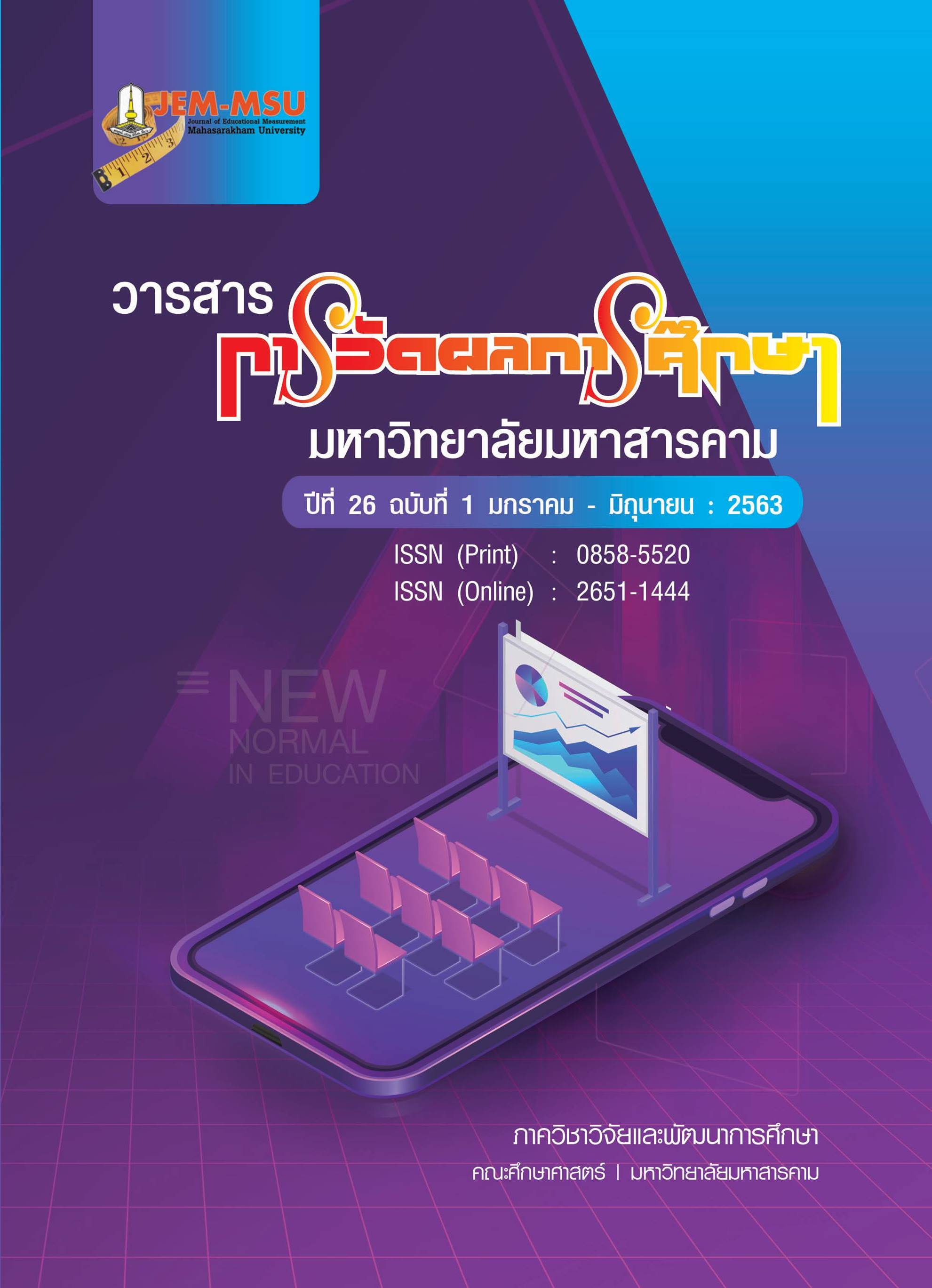Assessment of the Inclusive Education Project of Vocational and Higher Secondary Education Curriculums (Dual Education): A Case Study of Noensa-ard Wittayakom School, Using Responsive Evaluation Model Approach
Main Article Content
Abstract
This research aimed to assess the inclusive education project of vocational education curriculum and higher secondary education curriculum in Noensa-ard Wittayakom School, using responsive evaluation model approach which is a qualitative and quantitative assessment. There were 12 steps called “Responsive Clock.” The data sources comprised every group of stakeholders in the project. The tools used in the assessment were a questionnaire, an interview form, and focus group issues. Analysis of data from the questionnaire employed percentage, the mean and standard deviation, while analysis of data from the interview and the focus group issues employed content analysis and summary. For assessment issues, the assessor used the system approach to categorize the various assessment questions. The assessment results can be summarized as follows:
1) On the aspect of context, it was found that the overall objective of project was appropriate at a high level. It was consistent with the qualitative data about the reasons that students chose to study in the project.
2) On the aspect of input, it was found that the structure of the dual education curriculum on the part of the additional courses corresponded with courses in professional skill category of Phitsanulok Polytechnic College. The selection of teachers in the project was based on qualifications, knowledge, abilities and limitations in the teaching timetable. The media, materials, equipment and classroom condition including buildings were appropriate at a high level, but the focus group revealed that some media and equipment were insufficient. And the budget for learning consisted of expenses during the study and expenses during the practicum.
3) On the aspect of the process, the assessment revealed that: (1) regarding project publicity, off-campus guidance is the most effective form; (2) regarding the process of organizing for learning and teaching, teaching methods that focus on hands-on experience were interesting; they allowed students themselves to take action. However, from interviews, it was found that student class schedules were overlapping and there was a limitation of time to study, the students in the project could not participate in the school activities. (3) regarding transfer of learning outcome, it was found that the school did not use the guidelines on inclusive education (dual education) management. As a result, the students’ credits were not sufficient for graduation; (4) regarding the practicum, the students did not have the practicum in the field of study, and there were work disciplinary deficiencies. In addition, some enterprises did not open and close on time, and long distances from the students’ accommodation; and (5) regarding the supervision of teachers in Phitsanulok Polytechnic College, it was found that there were direct supervisions from Phitsanulok Polytechnic College director, colleagues, and from the professional standards office and the provincial superintendent.
4) Regarding the output, the entrepreneurs assessed that the overall quality of the learners was at a high level.
5) Regarding the impact, the number of students in the science-mathematics program decreased and the number of classrooms were not enough for students.
6) Regarding additional issues, it was found that the students wanted to have electrical technology, hotel studies, and the machine tool technology opened. In addition, the students who did not participate in this project commented that studying in the project was hard and the workload was abundant. Moreover, the fields that were opened for teaching did not match their interest, and the students aimed to continue their study at a university in an unrelated vocational field.
Article Details
The content and information contained in the published article in the Journal of Educational Measurement Mahasarakham University represent the opinions and responsibilities of the authors directly. The editorial board of the journal is not necessarily in agreement with or responsible for any of the content.
The articles, data, content, images, etc. that have been published in the Journal of Educational Measurement Mahasarakham University are copyrighted by the journal. If any individual or organization wishes to reproduce or perform any actions involving the entirety or any part of the content, they must obtain written permission from the Journal of Educational Measurement Mahasarakham University.
References
กระทรวงศึกษาธิการ. (2560). การปฏิบัติงานการจัดการศึกษาร่วมหลักสูตรอาชีวศึกษาและมัธยมศึกษาตอนปลาย (ทวิศึกษา) 2560. กรุงเทพฯ: โรงพิมพ์ชุมนุมสหกรณ์การเกษตรแห่งประเทศไทย.
กระทรวงศึกษาธิการ. (2557). นโยบายสำนักงานคณะกรรมการการศึกษาขั้นพื้นฐาน ปีงบประมาณ 2558. กรุงเทพฯ: โรงพิมพ์ชุมนุมสหกรณ์การเกษตรแห่งประเทศไทย.
ดำรงค์ ตุ้มทอง และ สายฝน วิบูลรังสรรค์. (2560). การประเมินแบบตอบสนอง: แนวคิดสู่การปฏิบัติมหาวิทยาลัยนเรศวร. วารสารวิชาการศึกษาศาสตร์ คณะศึกษาศาสตร์ มหาวิทยาลัยศรีนครินวิโรฒ, 18(1), 10 – 25.
ทิศนา แขมมณี. (2547). ศาสตร์การสอน. กรุงเทพฯ : สำนักพิมพ์แห่งจุฬาลงกรณ์มหาวิทยาลัย.
รัตนะ บัวสนธ์. (2560). ชุมนุมวิชาการด้านการวิจัยและวัดผลทางการศึกษา “การประเมินแบบมีส่วนร่วมและการประเมินแบบอาศัยฐานผู้เกี่ยวข้อง”. ได้จากhttp://www.rattanabb.com/modules. php?name=News&file. [สืบค้นเมื่อวันที่ 6 พฤษภาคม2562].
รัตนะ บัวสนธ์, สำราญ มีแจ้ง, สายฝน วิบูลรังสรรค์ และ ปุณิกา ศรีติมงคล. (2556). การพัฒนารูปแบบการประเมินผลการปฏิบัติงานอิงสมรรถนะ ของอาสาสมัครสาธารณสุขประจำหมู่บ้าน. วารสารวิทยาการวิจัยและวิทยาการปัญหา, 10(2), 96-107.
สุนทรา โตบัว, พนิต เข็มทอง และวรัทยา ธรรมกิตติภพ. (2561). ประเมินการนำแผนยุทธศาสตร์การพัฒนาชุมชนไปสู่การปฏิบัติด้วยการประเมินแบบตอบสนอง มหาวิทยาลัยเกษตรศาสตร์. วารสารวิชาการมหาวิทยาลัยธนบุรี, 12(3), 163-173.
สมหวัง พิริยานุวัฒน์. (2559). วิธีวิทยาการประเมินศาสตร์แห่งคุณค่า. (พิมพ์ครั้งที่ 6). กรุงเทพฯ: สำนักพิมพ์แห่งจุฬาลงกรณ์มหาวิทยาลัย.
อารีรัตน์ ชูรวง. (2560). การประเมินการจัดการศึกษาเรียนร่วมหลักสูตรอาชีวศึกษาและมัธยมศึกษาตอนปลาย(ทวิศึกษา).ของโรงเรียนราชประชานุเคราะห์ 23 จังหวัดพิษณุโลก.ได้จากhttp://www.rpg23.ac.th /content. [สืบค้นเมื่อวันที่ 14 มกราคม 2562].
Christina A. Christie & Marvin C. Alkin (2013). An Evaluation Theory Three in Marvin C. Alkin editor, Evaluation Root A wider Perspective of Theorists’ views and Influences. 2nd Ed. Sang
Padelford, H. E. (1984). Acquiring psychomotor skills. Journal of Epsilon Pi Tau, 10(2), 35 – 40.
Robert E. Stake. (2004). Standards – Based & Responsive Evaluation, USA: Sage publication.


